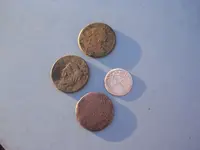I'm sure maybe some people would like to know about old coppers...so I will post this
I spent some time on the web looking for "brass or bronze colonial coins" Nothing of use...but..
I found a website describing counterfeit colonial coins, and still no references to brass or bronze...BUT! they mentioned different compositions of alloys like copper/lead/tin and zinc.
so I searched what brass is made of. It is made from copper and zinc.
I also found info on a pile of colonial coins from an excavation of an 1700s tavern in Pennsylvania, and there was a large percentage of these coins that were counterfeits " that were lost over a 20 year span there". Other websites also confirm the counterfeit coppers were rampant then.
The kicker was that counterfeits of harder alloys than pure copper will wear out the dies....so, many were cast instead of stamped..and "cast coins are slightly out of round, and also slightly smaller, due to the cooling shrinkage" of the alloy poured into a mold made from a genuine coin. (my coin is slightly smaller and slightly out of round)
Here are some paragraphs in case anyone cares:
**** " Struck counterfeit coins were made of almost pure copper as copper was soft enough so that it would not destroy the dies too quickly. However cast counterfeiters added several less expensive metals, notably lead, tin and sometimes zinc. Apparently there was no standard alloy, whatever metal was available was added to the mix. Three examples from the Smith and Mossman study demonstrate the variety of alloys used; there was a 1737 George II halfpenny made from 91.3% copper, 5% lead and 3.7 tin; a 1740 George II halfpenny made from 66% copper, 25.9% zinc, 4.7% lead and 3.2% tin; and a 1775 George III halfpenny composed of 82.9% copper, 12% lead and 5.1% tin."
*** "Generally cast coins have a slightly smaller diameter that official issues because molten metal will shrink somewhat as it cools. Also, because of the filing necessary to remove excess metal, many cast coins will be more oval (out of round) that struck example. On less circulated examples file marks can sometimes be seen on the edge or occasionally a "tab" can be seen that was not filed off."




